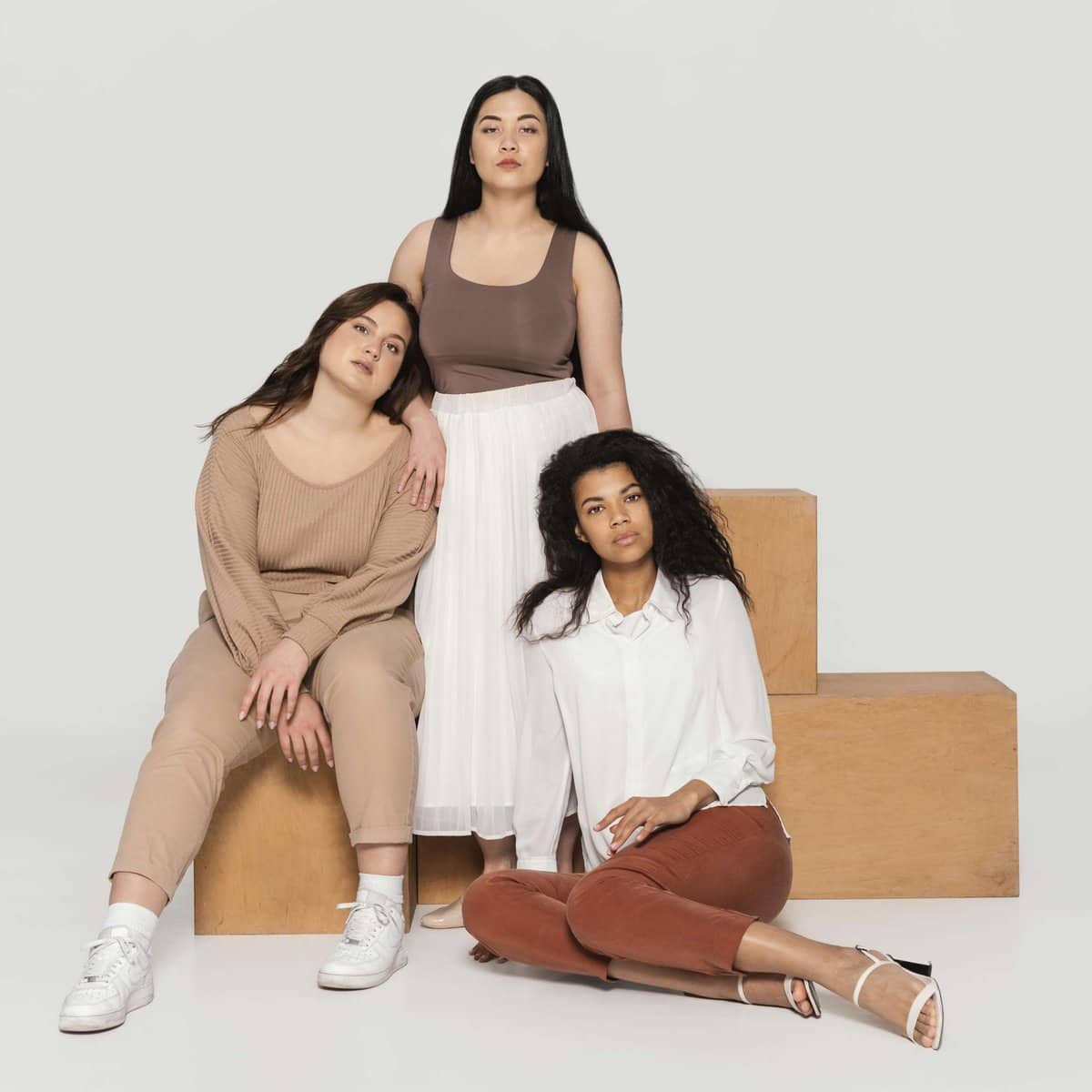Are you struggling to find the perfect clothing colors that flatter your skin tone? Well, look no further! We’ve got the key to selecting the best clothing for your skin color tone. By understanding your skin undertones, you can determine the colors that will complement your complexion the most. From vibrant jewel tones to earthy and warm shades, we’ll guide you through the color spectrum and help you create stylish looks that embrace your unique beauty. Get ready to make a bold statement with your wardrobe choices!
Understanding Skin Undertones
To understand the best clothing choices for your skin color tone, start by familiarizing yourself with the concept of skin undertones. Skin undertones play a crucial role in determining which colors will complement your complexion and make you look your best. Whether you have dark skin, light brown skin, caramel skin, or medium brown skin, understanding your skin undertones is key to finding the perfect colors for you.
For those with dark skin, shades like deep blues, purples, and emerald greens tend to look stunning. These bold and vibrant colors create a beautiful contrast with your complexion. Light brown skin tones can rock earthy tones like warm browns, oranges, and yellows. These colors bring out the warmth in your skin and enhance your natural glow. Caramel skin tones can embrace a wide range of colors, from warm neutrals to rich jewel tones. Experiment with shades like burnt orange, deep reds, and olive greens to find what suits you best. If you have medium brown skin, you can explore a variety of colors. Cool tones like lavender, dusty pinks, and icy blues work well, as do warm tones like golden yellows and rich browns.
Understanding your skin undertones opens up a world of possibilities when it comes to choosing the best clothing colors for you. Embrace your unique complexion and have fun experimenting with different shades that make you feel confident and beautiful.
Colors for Cool Undertones
If you have cool undertones, you’ll want to choose colors that complement your bluish undertone and blue veins. Colors like pink, green, purples, and reds are great options for you. These shades will contrast well with your cool skin tone and enhance your overall look.
Pink
When considering clothing options for cool undertones, incorporating pink can add a touch of femininity and softness to your overall look. Pink is a versatile color that can be worn by individuals with different skin tones. For those with light brown skin, shades of pink like blush or dusty rose can beautifully complement your complexion. If you have a medium skin tone, consider wearing a dress in a deeper shade of pink, such as magenta or fuchsia, to create a striking contrast. Dark-skinned individuals can also rock pink by opting for a bold, vibrant shade like hot pink or raspberry. As for accessories, a light green scarf or handbag can create a stunning contrast on dark skin. Remember, the key is to experiment and find the shades of pink that make you feel confident and beautiful.
Green
Continue exploring the best clothing options for cool undertones by incorporating the color green into your wardrobe. If you have cool undertones and light brown skin, you’ll be pleased to know that green is a great choice for you. Shades like emerald, mint, and olive can beautifully complement your complexion. The contrast between the green and your skin tone will create a striking and eye-catching look. On the other hand, if you have cool undertones and dark skin, light blue can be a fantastic option for you. This color will contrast beautifully with your skin tone, creating a vibrant and stunning effect. So, don’t hesitate to experiment with different shades of green and light blue to enhance your cool undertones and create fashionable and flattering outfits.
Purples
To continue enhancing your cool undertones and creating fashionable and flattering outfits, incorporate purples into your wardrobe. Purples are perfect for cool-toned individuals, as they complement the bluish undertone of your skin and add a touch of elegance to your look. Here are some ways you can incorporate purples into your wardrobe:
- Opt for rich jewel tones like royal purple, amethyst, and deep plum. These shades will enhance your cool undertones and make your skin glow.
- Experiment with different shades of purple, from lavender to lilac. These lighter shades can add a soft and feminine touch to your outfits.
- Mix and match purples with other cool colors like blues and grays for a harmonious and sophisticated look.
Red
For cool-toned individuals, incorporating reds into your wardrobe can enhance your cool undertones and add a bold and vibrant touch to your outfits. Red is a powerful color that can make a statement and bring attention to your cool complexion. When choosing red clothing, opt for shades that lean towards the cooler end of the spectrum, such as deep burgundy or raspberry. These shades will complement your cool undertones and create a visually striking look. Avoid reds that have warm undertones, like orange-red or coral, as they may clash with your cool complexion. To help you visualize the best red shades for cool undertones, refer to the table below:
| Cool Red Shades |
|---|
| Deep Burgundy |
| Raspberry |
| Ruby |
| Cranberry |
| Merlot |
Colors for Warm Undertones
Opt for shades that are slightly brighter or darker than the middle ground to complement your warm undertones. When it comes to choosing colors for warm skin tones, there are plenty of options that will enhance your natural glow. Here are some suggestions to help you make the perfect choice:
- Earthy and warm colors: Red, orange, and yellow are your go-to colors. These shades bring out the warmth in your complexion and create a vibrant look. Embrace the earthy tones like olive green and brown, as they will complement your warm undertones beautifully.
- Gold jewelry: Gold enhances warm skin tones, so don’t be afraid to accessorize with your favorite gold pieces. They will add a touch of luxury and elegance to your overall look.
- Warm pastel shades: Experiment with warm pastel shades like peach, coral, and blush pink. These soft hues will give you a fresh and youthful appearance.
Remember to avoid wearing colors that wash out your warm skin tones, such as icy pastels or bright white. Also, steer clear of shades of yellow or green that are too close to your skin tone. By opting for the right shades, you can highlight your warm undertones and create a flattering and harmonious look.
Colors for Neutral Skin Tone
When determining the best clothing for your neutral skin tone, consider a wide range of colors that complement your balanced undertones. Neutral skin tones allow for versatility in color choices, as most hues and shades will complement your complexion. You have the unique advantage of being able to wear both warm and cool shades. Experiment with different colors to find what suits you best.
When choosing colors for your neutral skin tone, it’s important to balance bold, bright colors with a color that holds the look together. You can choose a single pop of color or two that complement each other. However, it’s recommended to avoid yellow, as it may not contrast enough with neutral skin.
In addition, consider your personal style and self-expression when choosing colors. Confidence is key when wearing colors that make you feel good. Remember that there is no strict color chart based on skin tone, so trust your own judgment and use the mirror as a tool to determine what looks best on you.
Tips and Considerations
To make the best clothing choices for your skin color tone, consider these tips and considerations:
- Personal style and self-expression are important in choosing colors. Don’t be afraid to experiment and showcase your unique taste.
- Confidence is key when wearing colors that make you feel good. Embrace your skin tone and rock the colors that make you shine.
- Consider colors that work well together. Think about complementary shades or creating a color palette that suits your undertones.
- For cool undertones, opt for darker colors that contrast with your skin tone. Purples, greens, and charcoal gray are great options.
- If you have warm undertones, embrace earthy and warm colors like red, orange, and yellow. Olive green and brown are also flattering.
- Neutral skin tones allow for versatility, so feel free to experiment with a wide range of colors. Balance bold, bright colors with a color that holds the look together.
Understanding Skin Tone and Determining Skin Tone
To understand your skin tone and determine the best clothing choices, start by identifying the undertones in your skin. Undertones are the subtle hues that lie beneath your skin’s surface and can be categorized as warm, cool, or neutral. Warm undertones have yellow or golden hues, while cool undertones have pink or bluish hues. Neutral undertones have a balance of warm and cool hues.
To determine your undertones, take a look at the veins on your wrist. If your veins appear greenish, you likely have warm undertones. If your veins appear bluish, you likely have cool undertones. If you can’t quite tell or your veins appear both greenish and bluish, you may have neutral undertones.
Another method to determine your undertones is the white paper test. Hold a piece of white paper next to your face and observe how your skin looks in comparison. If your skin appears more yellow or golden, you likely have warm undertones. If your skin appears more pink or rosy, you likely have cool undertones. If your skin looks neither too yellow nor too pink, you may have neutral undertones.
Understanding your skin undertones is essential in choosing clothing colors that flatter your complexion. By knowing your undertones, you can select colors that enhance your natural beauty and make you feel confident and comfortable. So take a moment to determine your undertones and unlock a world of fashion possibilities tailored to your unique skin tone.
Choosing Colors for Warm Skin Tones
If you have warm skin tones, opt for earthy and warm colors such as red, orange, and yellow to enhance your complexion. Here are some tips to help you choose the best colors for your warm skin tone:
- Earthy shades: Shades like olive green and brown complement warm skin tones beautifully. They bring out the warmth in your complexion and create a harmonious look.
- Gold jewelry: Gold jewelry is a perfect match for warm skin tones. It adds a touch of luxury and complements your natural warmth.
- Warm pastels: Warm-toned individuals can experiment with warm pastel shades such as peach, coral, and salmon. These colors add a soft and feminine touch to your look.
Remember, when choosing colors for your warm skin tone, avoid wearing colors that wash you out. Icy pastels and bright white can make your complexion appear dull. Instead, opt for shades that are slightly brighter or darker than the middle ground.
Choosing Colors for Cool Skin Tones
For individuals with cool skin tones, jewel tones like blue, purple, and emerald green are the best colors to enhance their complexion. These vibrant and rich hues complement the bluish undertones of cool-toned individuals, making their skin appear more radiant and vibrant. Cool-toned individuals can also experiment with icy pastels and bright whites, which create a fresh and crisp look. Silver jewelry is the perfect accessory choice for cool skin tones, as it further enhances their cool undertones.
When it comes to avoiding colors that clash with cool skin tones, it’s best to steer clear of warm and vibrant shades like orange and yellow. These colors can make cool-toned individuals look washed out and can create an unflattering contrast with their complexion. Instead, opt for neutral colors like black, gray, and navy, which can be flattering and versatile for cool skin tones.
Choosing Colors for Neutral Skin Tones
When choosing colors for neutral skin tones, you frequently have the versatility to wear a wide range of hues and shades that complement your complexion. Here are some tips to help you make the best color choices:
- Experiment with both warm and cool shades: With a balance of warm and cool undertones, neutral-toned individuals can wear a variety of colors. Don’t be afraid to try both warm and cool shades to see what works best for you.
- Find the right jewelry: Since neutral skin tones can lean towards both warm and cool, experiment with both gold and silver jewelry to see which complements your skin tone best.
- Balance bold colors: When wearing bright and bold colors, it’s important to choose a color that holds the look together. Opt for a single pop of color or two that complement each other and create a harmonious balance.
Additional Considerations for Choosing Colors
Consider your hair color and makeup choices when selecting colors that complement your skin tone. Your hair color can greatly influence how certain colors will look on you. For example, if you have warm-toned skin and blonde hair, earthy shades like red, orange, and yellow can enhance your complexion. On the other hand, if you have cool-toned skin and dark brown hair, jewel tones like blue, purple, and emerald green can bring out the best in you.
Makeup choices are also important in complementing your skin tone. When choosing makeup colors, consider the undertones of your skin. If you have warm undertones, opt for warm-toned makeup shades like peachy blushes and golden eyeshadows. For cool undertones, choose cool-toned makeup shades like pink blushes and silver eyeshadows. Additionally, consider the occasion and the desired mood when choosing colors. Soft pastels and neutrals can create a romantic and soft look, while bold and bright colors can make a statement.
Incorporating patterns and prints into your outfits can also add interest and complement your skin tone. Consider wearing patterns or prints that have colors that match or enhance your skin tone. For warm skin tones, try floral prints with warm hues like red or orange. For cool skin tones, opt for prints with cool hues like blue or purple. Remember, personal preference and individual style should also be taken into account when choosing colors. Experiment with different shades and combinations to find what makes you feel confident and comfortable.


